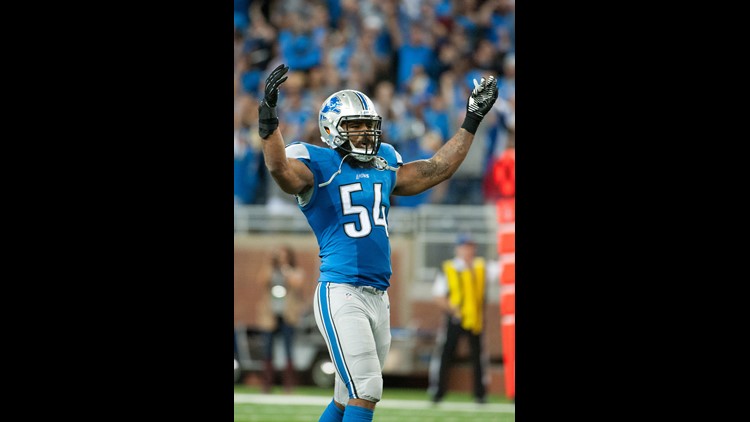“It’s scary to think I may have CTE.” — Detroit Lions linebacker DeAndre Levy
Imagine the impact on the NFL, and the sports community at large, when the day comes that there’s a definitive test to diagnose chronic traumatic encephalopathy (CTE) in the living.
Players such as Levy might not have to guess whether repetitive head trauma thought to be a root cause of CTE has left them with a brain illness that could affect them for the rest of their lives.
A CTE test might provide the answers — hopefully in step with treatment that makes a difference.
That day can’t get here soon enough.
“The science will connect the dots at some point,” former NFL defensive end Marvin Washington told USA TODAY Sports during the weekend. “It will change football.”
At the moment, CTE is only definitively confirmed in subjects posthumously, by examining brain tissue that reveals abnormal levels of tau protein.
Chris Nowinski, co-founder of the Concussion Legacy Foundation, said experts had expressed optimism that a CTE test for the living would be developed within five years.
In addition to determining what percentage of football players, and others in activities considered to be at risk, have signs revealing the existence of CTE, Nowinski wonders about the medical recommendations that would stem from such a diagnosis.
“I would hope it would be to stop playing, with aggressive treatment that would hopefully slow the progress of the disease,” said Nowinski, whose front-line work includes securing brains of the deceased for study as his group partners with Boston University and the Veteran’s Administration.
“But can you really stop a 22- or 23-year-old from playing?”
Washington, who played for 11 NFL seasons, is involved with a company, Kannalife Sciences Inc., that is conducting clinical trials using cannabidiol as an agent to treat traumatic brain injuries. He can see the day when a CTE test, perhaps with grades that identify stages that underscore risk, is a standard component in evaluating players.
“At the combine, a guy who has had three or four concussions might be like a guy who had two ACL (tears) in college,” Washington surmised. “That hurts his stock. Maybe it will get to the point where they can determine if someone is one or two hits away from permanent damage.”
That’s a sobering thought, for sure, but imagine the risk management. With intense research efforts to develop a test that on the landscape of the concussion crisis would be like finding the Holy Grail, the culture shift in football is undoubtedly still in the early stages.
“It’s great to see the rules changes to make the game safer,” Nowinski said. “The one thing that’s missing now is an honest discussion about the risks. If you’re a football player, I’d have to imagine that you’re confused by what you hear coming from the NFL.”
In his thoughtful, 1,000-word letter to the Detroit Free Press this week, — a follow-up to his rebuke on Instagram of Indianapolis Colts owner Jim Irsay, who poorly compared the risks of football to reactions different people can experience when taking aspirin — Levy maintained that he might already have CTE.
![Letter from Detroit Lions LB DeAndre Levy: Scary that I may have CTE [oembed : 82563822] [oembed : 82563822] [oembed : 82563822] [oembed : 82563822]](/Portals/_default/Skins/PrestoLegacy/CommonCss/images/smartembed.png)
Levy wrote, not surprisingly, that it’s a sentiment shared with several of his NFL peers as awareness increases of long-term risks from head injuries. And there are many more retired players expressing a similar theme.
Levy’s hunch, he wrote, is fueled by symptoms. Headaches. Memory loss. Cognitive disorders. Mood swings. The symptoms don’t necessarily add up to CTE, but clearly there are issues.
Add that to the cases of CTE confirmed in the bodies of younger people — Junior Seau was 43, Tyler Sash 27 and Chris Henry 26, and there were former high school players diagnosed at 17 and 18 — the evolving research has shown that the brain disease isn’t developed only in older subjects, decades after they finished their playing careers.
It’s no wonder Levy calls his situation scary.
He said his fear wasn’t to the point where he would walk away from football as Kansas City Chiefs safety Husain Abdullah did this week, retiring after seven seasons, citing concern of long-term effects on his health. Levy accepts the risks of football.
![Bell: Retired NFL players joining effort to prevent, treat effects of head injuries [oembed : 82563884] [oembed : 82563884] [oembed : 82563884] [oembed : 82563884]](/Portals/_default/Skins/PrestoLegacy/CommonCss/images/smartembed.png)
Yet if there were more definitive answers with a CTE test for the living, I wonder if that would be the swing factor on the other side of risk.
“Would it get to a point where players would sign a waiver and absolve the NFL of any damages?” pondered Washington, who retired after the 1999 season and said he had not experienced any alarming health issues. “I just don’t see too many guys putting their long-term health on the line, if they have the information.”
What better information than a test to confirm CTE in the living.



![XXX IMG_USATSI_8197310_1_1_HNB8TE2U.JPG S FBN USA MI [image : 82564024]](http://www.gannett-cdn.com/media/2016/04/02/USATODAY/USATODAY/635952197979016468-XXX-IMG-USATSI-8197310-1-1-HNB8TE2U.JPG)
